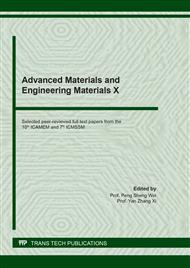[1]
G.C. Onwubolu, F.Rayegani, Characterization and optimization of mechanical properties of ABS parts manufactured by the fused deposition modelling process. Int J Manuf Eng (2014) 598531.
DOI: 10.1155/2014/598531
Google Scholar
[2]
X.Wang, M. Jiang, Z. Zhou, J. Gou, D. Hui, 3D printing of polymer matrix composites: A review and prospective, Compos. Part B 110 (2017) 442–458.
DOI: 10.1016/j.compositesb.2016.11.034
Google Scholar
[3]
B. N. Turner, R. Strong, S. A. Gold, A review ofmelt extrusion additive manufacturing processes: I. Process design and modeling, Rapid Prototyp. J. 20 (3) (2014) 192–204.
DOI: 10.1108/rpj-01-2013-0012
Google Scholar
[4]
B. Utela, D. Storti, R. Anderson, M. Ganter, A review of process development steps for new material systems in three dimensional printing (3DP), J.Manuf. Process. 10 (2) (2008) 96–104.
DOI: 10.1016/j.jmapro.2009.03.002
Google Scholar
[5]
M. Vaezi, H. Seitz, S. Yang, A review on 3D micro-additive manufacturing technologies, Int. J Adv. Manuf. Technol. 67 (5–8) (2013) 1721–1754.
DOI: 10.1007/s00170-012-4605-2
Google Scholar
[6]
V.Francis, P.K. Jain, Investigation on the effect of surface modification of 3D printed parts by nanoclay and dimethyl ketone. Mater Manuf Process 33(2018) 1080–1092.
DOI: 10.1080/10426914.2017.1401717
Google Scholar
[7]
P. Zhang, D.J. Arceneaux, Z. Liu, P. Nikaeen, A. Khattab, G. Li, A crack healable syntactic foam reinforced by 3D printed healing-agent based honeycomb, Compos. Part B 151 (2018) 25–34.
DOI: 10.1016/j.compositesb.2018.06.005
Google Scholar
[8]
T. Li, L.Wang, Bending behavior of sandwich composite structures with tunable 3Dprinted core materials, Compos. Struct. 175 (2017) 46–57.
DOI: 10.1016/j.compstruct.2017.05.001
Google Scholar
[9]
Y.-T. Kao, A.R. Amin, N. Payne, J. Wang, B.L. Tai, Low-velocity impact response of 3D printed lattice structure with foam reinforcement, Compos. Struct. 192 (2018) 93–100.
DOI: 10.1016/j.compstruct.2018.02.042
Google Scholar
[10]
G. Ma, L. Wang, A critical review of preparation design and workability measurement of concrete material for large scale 3D printing, Front. Struct. Civ. Eng. 12 (3) (2018) 382–400.
DOI: 10.1007/s11709-017-0430-x
Google Scholar
[11]
P.Wu, J.Wang, X.Wang, A critical review of the use of 3-D printing in the construction industry, Autom. Constr. 68 (2016) 21–31.
Google Scholar
[12]
R.Wolfs, F. Bos, T. Salet, Early age mechanical behaviour of 3D printed concrete: numerical modelling and experimental testing, Cem. Concr. Res. 106 (2018) 103–116.
DOI: 10.1016/j.cemconres.2018.02.001
Google Scholar
[13]
B. Panda, J.H. Lim, M.J. Tan, Mechanical properties and deformation behaviour of early age concrete in the context of digital construction, Compos. Part B 165 (2019) 563–571.
DOI: 10.1016/j.compositesb.2019.02.040
Google Scholar
[14]
B. Henriques, P. Pinto, F. Silva, M. Fredel, D. Fabris, J. Souza, O. Carvalho, On the mechanical properties of monolithic and laminated nano-ceramic resin structures obtained by laser printing, Compos. Part B 141 (2018) 76–83.
DOI: 10.1016/j.compositesb.2017.12.044
Google Scholar
[15]
B.H. Lee, J. Abdullah, Z.A. Khan, Optimization of rapid prototyping parameters for production of flexible ABS object, J. Mater. Process. Technol. 169 (1) (2005) 54–61.
DOI: 10.1016/j.jmatprotec.2005.02.259
Google Scholar
[16]
H.H. Malik, A.R. Darwood, S. Shaunak, P. Kulatilake, A. Abdulrahman, O. Mulki, A. Baskaradas, Three-dimensional printing in surgery: a review of current surgical applications, J. Surg. Res. 199 (2) (2015) 512–522.
DOI: 10.1016/j.jss.2015.06.051
Google Scholar
[17]
J.S. Mulford, S. Babazadeh, N. Mackay, Three-dimensional printing in orthopaedic surgery: review of current and future applications, ANZ J. Surg. 86 (9) (2016) 648–653.
DOI: 10.1111/ans.13533
Google Scholar
[18]
H.N. Chia, B.M.Wu, Recent advances in 3D printing of biomaterials, J. Biol. Eng. 9 (1) (2015) 4.
Google Scholar
[19]
N.A. Ahmed, J. Page, Manufacture of an unmanned aerial vehicle (UAV) for advanced project design using 3D printing technology, Applied Mechanics and Materials, Trans Tech Publ 2013, p.970–980.
DOI: 10.4028/www.scientific.net/amm.397-400.970
Google Scholar
[20]
E. Kroll, D. Artzi, Enhancing aerospace engineering students' learning with 3D printing wind-tunnel models, Rapid Prototyp. J. 17 (5) (2011) 393–402.
DOI: 10.1108/13552541111156522
Google Scholar
[21]
F. Pallottino, L. Hakola, C. Costa, F. Antonucci, S. Figorilli, A. Seisto, P.Menesatti, Printing on food or food printing: a review, Food Bioprocess Technol. 9 (5) (2016) 725–733.
DOI: 10.1007/s11947-016-1692-3
Google Scholar
[22]
J. Sun, Z. Peng,W. Zhou, J.Y. Fuh, G.S. Hong, A. Chiu, A review on 3D printing for customized food fabrication, Procedia Manufacturing 1 (2015) 308–319.
DOI: 10.1016/j.promfg.2015.09.057
Google Scholar
[23]
S.H. Ahn, M.Montero, D .Odell, S.Roundy, P.K. Wright, Anisotropic material properties of fused deposition modeling ABS. Rapid Prototyp J 8(2002) 248–257.
DOI: 10.1108/13552540210441166
Google Scholar
[24]
M.Grasso, A.Lyes, P.R. Hincapie, M.Zarrelli, G.Ren, Effect of temperature on the mechanical properties of 3D-printed PLA tensile specimens.. Rapid Prototyp J 24 (2018) 1337–1346.
DOI: 10.1108/rpj-04-2017-0055
Google Scholar
[25]
M.Seif, Failure Analysis and Quality Assessment of 3D Printed ABS Parts. ASME 2018 13th International Manufacturing Science and Engineering Conference (2018) V001T01A034.
DOI: 10.1115/msec2018-6578
Google Scholar


